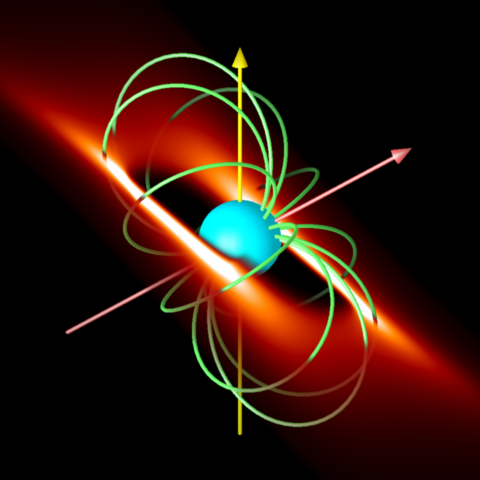Rigidly Rotating Magnetosphere model
The RRM model introduced by Townsend & Owocki (2005) gives a semi-analytical prescription for the circumstellar matter distribution around a rotating star with a strong magnetic field.
Basic Principles

A simulation of the circumstellar matter distribution of σ Ori E, as predicted by the Rigidly Rotating Magnetosphere mode
The model is built on the notion that upflowing wind material, flowing along fixed trajectories prescribed by rigid field lines, experiences an effective potential arising from a combination of the stellar gravitational field and the centrifugal force due to co-rotation. In the vicinity of points where the effective potential undergoes a local minimum, as sampled along a field line, the material can settle into a stable configuration of magnetohydrostatic equilibrium. Physically, this equilibrium comes about when the outward centrifugal force exceeds the inward pull of gravity, thereby supporting the material near the tops of magnetic loops. (Magnetic tension prevents the material from simply escaping to infinity).
A strength of the RRM model is its ability to predict the relative matter distribution for arbitrary magnetic field configurations. In the specific case of an oblique-dipole field, the model indicates that the matter is mainly confined into two two clouds, situated at the intersections between magnetic and rotational equators. Such a distribution coincides with the observationally inferred picture of σ Ori E, and the RRM model is proving very successful in understanding this particular star and related objects (see Townsend et al. 2005).
Visualization
Selected Bibliography
- Townsend & Owocki (2005) — the original RRM paper
- Townsend, Owocki & Groote (2005) — application to σ Ori E
- ud-Doula, Townsend & Owocki (2006) — MHD models demonstrate the centrifugal breakout predicted by the RRM model
- Townsend (2009) — light-curve synthesis
